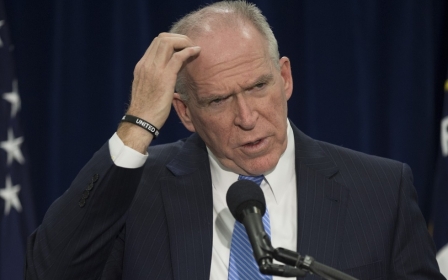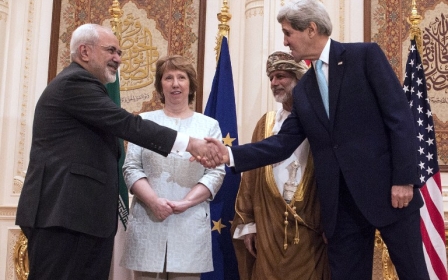Guess who credits the Mossad with producing the 'laptop documents?'

In the United States and Europe, it is unchallenged in political and media circles that intelligence documents purporting to be from a covert Iranian nuclear weapons program for which the IAEA long demanded an Iranian explanation are genuine.
But evidence has continued to accumulate that the documents - sometimes called the “laptop documents” because they were said to have been on a laptop computer belonging to one of the participants in the program - were fabricated by Israel’s foreign intelligence agency (Mossad). We now know that the documents did not come from an Iranian participant in the alleged project, as the media were led to believe for years; they were turned over to German intelligence by the anti-regime Iranian terrorist organisation, Mujahedeen E Khalq, (MEK). I first reported this in 2008 and have now confirmed from an authoritative German source in my book on the Iran nuclear issue. The MEK was well known to have been a client of the Mossad, serving to launder Israeli intelligence claims that the Israelis did not want attributed to themselves.
Although it has never been mentioned in news media, former International Atomic Energy Agency (IAEA) Director General, Mohamed El Baradei recalled in his memoirs that he was doubtful of the authenticity of the documents. “No one knew if any of this was real,” he wrote in reference to the laptop documents. Another former senior IAEA official told me, “It just really didn’t add up. It made more sense that this information originated in another country.” And as I have detailed in articles and in my book, key documents in the collection bear clear indications of fabrication.
Support for that virtually unknown part of the Iran nuclear story has come from a surprising source: a popular Israeli account, celebrating the successes of the Mossad’s covert operations. “Mossad: The Greatest Missions of the Israeli Secret Service,” first published in Hebrew in 2010, and then published in English in 2012, was Israel’s best-selling book for months in 2010. But not only does it acknowledge that it was indeed the MEK that delivered the documents, it also suggests that at least some of the documents came from the Mossad.
The co-authors of the book are far from critics of Israel’s policy toward Iran; One of the co-authors, Michael Bar-Zohar, is a well-connected former member of the Israeli Knesset and former paratrooper, who had previously written an authorised biography of Shimon Peres, as well as the biography of Isser Harel, the Mossad chief who presided over the kidnapping of Adolph Eichmann in Argentina.
Much of what Bar-Zohar chronicled in the book had already been reported earlier by Israeli journalists - especially Ronen Bergman of the daily Yedioth Ahronoth. In fact, Bergman accused Bar-Zohar of plagiarising his articles for much of the book, while changing only a few words.
But one thing that Bar-Zohar and co-author Nisham Mishal did not get from other Israeli journalists, was the role of the Mossad in regard to the laptop documents.
Although they do not flatly state that the Mossad was the source of the documents, they certainly lead the reader to that conclusion. They begin by establishing the fact that the MEK was fronting for the Mossad in its revelation in August 2002 of Iran’s first enrichment facility at Natanz. The CIA, they write, “appeared to believe that the Mossad and the British MI6 were feeding MEK intelligence they had obtained, using the Iranian opposition as a hopefully credible source”. And they explicitly confirm CIA’s suspicions. “According to Israeli sources,” they write, “It was, in fact, a watchful Mossad officer who had discovered the mammoth centrifuge installation at Natanz.”
Other sources, including Seymour Hersh and Connie Bruck have reported that the MEK got the intelligence on Natanz from the Israelis, but theirs is the first explicit acknowledgement attributed to an Israeli source that the MEK had revealed Natanz on the basis of Mossad intelligence. What the Israeli co-authors do not say is that the Mossad was simply guessing at the purpose of Natanz, which the MEK mistakenly called a “fuel fabrication” facility, rather than a centrifuge enrichment facility.
Turning to the laptop documents, they make it clear that western intelligence had indeed obtained the documents from the MEK and suggest that the MEK got them from somewhere else. “The dissidents wouldn’t say how they had gotten hold of the laptop,” they write. They again frame the question of the origins of those documents in terms of CIA suspicions. “[T]he skeptical Americans suspected that the documents had been only recently scanned into the computer,” they write. “They accused the Mossad of having slipped in some information obtained from our own sources - and passing it to the MEK leaders for delivery to the West."
Bar-Zohar and Mishal steer clear of any suggestion that the Mossad fabricated any documents, but their account leaves little doubt that they are convinced that the Mossad should be credited for the appearance of the documents. Their approach of referring to US suspicions, rather than stating it directly, appears to be a way of avoiding problems with Israeli military censors, who often clamp down on local reporting on sensitive issues while allowing references to foreign reports.
The authors further suggest that the Mossad was behind information later released by the MEK on Mohsen Fakhrizadeh, the Iranian physics professor said to be shown in the laptop documents as the man in charge of that purported Iranian nuclear weapons research program. The MEK disclosed such personal details as Fakhrizadeh’s passport number and his home telephone number. But the Mossad chroniclers write: “This abundance of detail and means of transmission leads one to believe that, again, “a certain secret service” ever suspected by the West of pursuing its own agenda, painstakingly collected these facts and figures about the Iranian scientists and passed them to the Iranian resistance.”
I asked Bar-Zohar’s research assistant, Nilly Ovnat, whether he had Israeli sources for those statements relating to the MEK and the laptop documents. She responded by e-mail: “Professor Bar Zohar had other sources for most of the material concerning MEK and Natanz [and the] laptop, yet they could not be mentioned and cannot be discussed.”
Bar-Zohar and Mishal are little concerned with whether the Mossad’s laptop caper involved fraud or not. They obviously view the Israeli intelligence agency’s use of an Iranian exile group to get out documents that had been central to the international sanctions regime against Iran as a great triumph. But whatever their reasons, their book adds another layer to the growing body of evidence showing that the Bush administration and its allies hoodwinked the rest of the world with those documents.
- Gareth Porter is an independent investigative journalist and historian writing on US national security policy. His latest book, “Manufactured Crisis: The Untold Story of the Iran Nuclear Scare,” was published in February 2014.
The views expressed in this article belong to the author and do not necessarily reflect the editorial policy of Middle East Eye.
Photo: Benjamin Netanyahu and former Israeli Minister Rafi Eitan (2nd L), who was a member of the Mossad team that captured Adolf Eichmann in Argentina in 1960, look at objects displayed at an exhibition at the Knesset in Jerusalem on 12 December, 2011(AFP)
Stay informed with MEE's newsletters
Sign up to get the latest alerts, insights and analysis, starting with Turkey Unpacked
Middle East Eye delivers independent and unrivalled coverage and analysis of the Middle East, North Africa and beyond. To learn more about republishing this content and the associated fees, please fill out this form. More about MEE can be found here.





